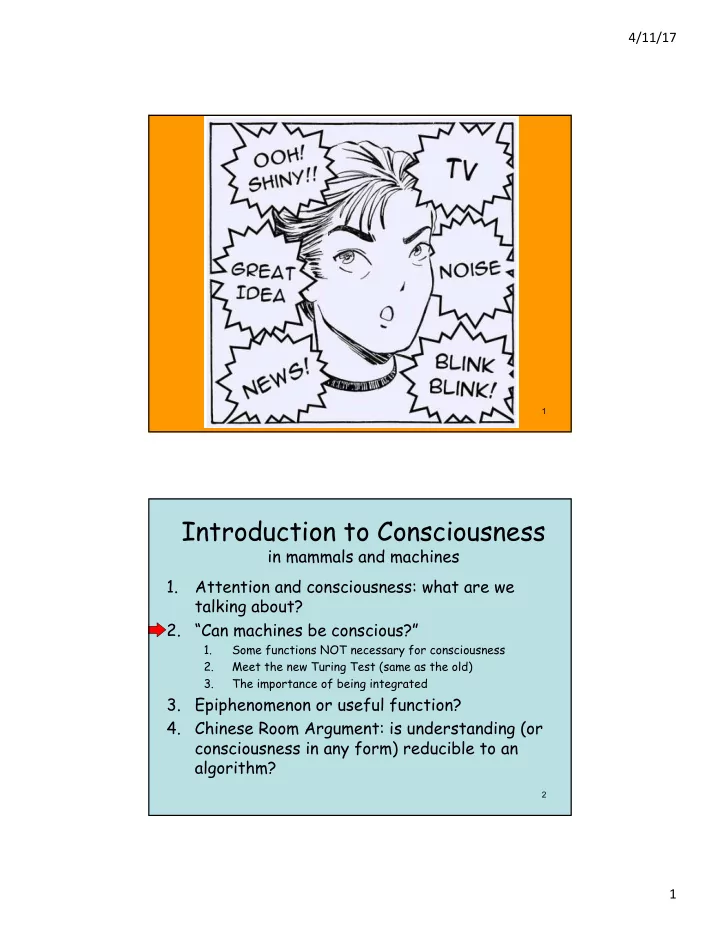

4/11/17 1 Introduction to Consciousness in mammals and machines 1. Attention and consciousness: what are we talking about? 2. “Can machines be conscious?” 1. Some functions NOT necessary for consciousness 2. Meet the new Turing Test (same as the old) 3. The importance of being integrated 3. Epiphenomenon or useful function? 4. Chinese Room Argument: is understanding (or consciousness in any form) reducible to an algorithm? 2 1
4/11/17 • According to Koch and Tononi, what are some prerequisites for consciousness? • And what are some things they say are NOT required for consciousness? Information is: how many possibilities get ruled out Claude Shannon 1916-2001 2
4/11/17 A single integrated whole: the intrinsic unity of conscious experience The Binding Problem “Exactly how the parallel streams of sensory data are melded into perception, images, and ideas remains the Holy Grail of neuroscience.” 6 3
4/11/17 7 From “A Neuroscientist’s Radical Theory of How Networks Become Conscious 2013 4
4/11/17 A new Turing test? Introduction to Consciousness in mammals and machines 1. Attention and consciousness: what are we talking about? 2. “Can machines be conscious?” 1. Some functions NOT necessary for consciousness 2. Meet the new Turing Test (same as the old) 3. The importance of being integrated 3. Epiphenomenon or useful function? 4. Chinese Room Argument: is understanding (or consciousness in any form) reducible to an algorithm? 10 5
4/11/17 Epiphenomenalism Mental events are caused by physical events in the brain, but have no effects upon any physical events. 11 12 6
4/11/17 William James’ evolutionary argument against epiphenomenalism • Conscious states correspond to our situation w.r.t. surviving and thriving (e.g. fire hurts), suggesting they are adaptations that evolved • But to evolve by natural selection they must have effects on physical behavior 13 So what is consciousness for? • Provides an “ executive summary ” of the current situation, useful for learning and planning • For dealing with novel situations where unconscious specialist modules don’t know what to do, or disagree with each other (cf. “advisors” in SemaFORR robot) 14 7
4/11/17 Bernard Baars Functional metaphor: BLACKBOARD used by a committee of experts 15 • Theatre metaphor NEURAL AUDIENCE 16 8
4/11/17 Introduction to Consciousness in mammals and machines 1. Attention and consciousness: what are we talking about? 2. “Can machines be conscious?” 1. Some functions NOT necessary for consciousness 2. Meet the new Turing Test (same as the old) 3. The importance of being integrated 3. Epiphenomenon or useful function? 4. Chinese Room Argument: is understanding (or consciousness in any form) reducible to an algorithm? 17 Searle's Chinese Room Argument against “the mind is the program” • Put me in a room with Chinese character cards and rule book • Receive cards through window and follow rules to output cards that answer questions on input cards • I implement the program, but I do not understand Chinese • Therefore, understanding Chinese is more than just a program or function 18 9
4/11/17 19 Attention! 1. Definitions and behavioral effects 2. Effects on neural firing rates: Spatial attention Attention to features 3. Directing attention: Posterior parietal cortex Frontal eye fields Top-down and bottom-up attention 20 10
4/11/17 Attention chooses what enters consciousness “Everyone knows what attention is. It is the taking possession by the mind, in clear and vivid form, of one out of what seem several simultaneously possible objects or trains of thought. Focalization, concentration, of consciousness are of its essence. It implies withdrawal from some things in order to deal effectively with others…” —William James Principles of Psychology 1890 21 Attention A state of selectively processing some sources of perceptual information while ignoring others or A process that selectively allocates a limited capacity cognitive resource 22 11
4/11/17 Attentional cue: 80% valid Detection task: target flash on left, right, or not at all? Covert attention shift: no eye movement 23 Attention enhances detection 24 12
4/11/17 Attention increases reaction speed 25 Treisman’s Feature Integration Theory (Lab 9 visual search) Decomposed Synthesized Analyzed Integrated 26 13
4/11/17 27 28 14
4/11/17 “Illusory conjunctions” when attention is taxed 29 Bottom-up Top-down • Stimulus-driven: • Goal-driven: salience, automatic voluntary, effortful • Feed-forward neural • Feed-back neural projections projections • Faster • Slower • e.g. • e.g. Loud noise, flash of light Looking for keys POPOUT! CONJUNCTION SEARCH 30 15
Recommend
More recommend